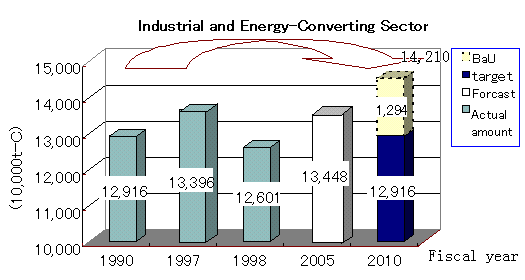In the 2nd Follow-up, three new industries (Japan Bearing Industrial Association, Japan Dairy Products Association, and Japan Soft Drink Bottlers Association) joined the 28 from last year to bring the total number of industries participating in the follow-up to 311. These 31 industries emitted 129 million t-C2 of CO2 in fiscal 1990, or approximately 42% of the 306.7 million t-C of CO2 emitted by Japan as a whole during that year. Moreover, the emissions of these 31 industries represented approximately 75% of the CO2 emitted by the country's entire industrial and energy-converting sector (171 million tons3 in fiscal 1990).
Declaring that its goal will be "to endeavor to reduce CO2 emissions from the industrial and energy-converting sector to below the level of 1990 in 2010," Keidanren is endeavoring to achieve this target in conjunction with industries and companies. Results from the 2nd Follow-up indicate that CO2 emissions in fiscal 1998, the year covered by the current follow-up, were 126 million t-C, or 2.4% less than fiscal 1990 and 6% less than fiscal 1997.
In addition, based on the current follow-up, CO2 emissions are forecast to be 133 million t-C in fiscal 2005 (roughly 4% higher than in fiscal 1990) and, on a business-as-usual basis, 142 million t-C in fiscal 2010 (approximately 10% above the level of fiscal 1990).
|
CO2 Emissions4 by Industry As a Whole (Industrial and Energy-Converting Sector) | ||||||||||||
| (Expressed in: t-C) | ||||||||||||
|

The decline in CO2 emissions from the industrial and energy-converting sector in fiscal 1998 can be attributed to lower production output by the materials fabrication sector, among others, and to efforts by industries and companies to improve their CO2 emissions per unit output and energy consumption per unit output.
In fiscal 1998, CO2 emissions declined below the level of fiscal 1990 due to trends in the economy. However, as noted above, industries are forecasting an increase of approximately 4% in fiscal 2005 compared to 1990, indicating a need for industry to continue endeavoring to achieve its initial goals.
Of the 31 industries in the industrial and energy-converting sector, 20 industries registered declines in CO2 emissions vis-à-vis fiscal 1990, while 27 registered declines vis-à-vis fiscal 1997 (with two others registering no change, and two registering increases). In addition, of the 24 industries that have declared goals or forecasts in terms of CO2 emissions per unit output or energy consumption per unit output, 17 registered improvements compared to fiscal 1990. Of these 17, 10 also registered improvements compared to fiscal 1997 (see Attachments 1 and Attachments 2).
Calculations exist showing that Japan's total CO2 emissions in fiscal 1998 increased sharply compared to fiscal 19905. Under such conditions, even though economic trends influenced the outcome, we speculate that the findings in the current follow-up of a 2.4% reduction in total CO2 emissions by industry overall (industrial and energy-converting sector) merit a positive appraisal. At the same time, even if industry executes its global warming measures, current forecasts indicate that emissions by industry as a whole are on an upward trend through around fiscal 2005, notwithstanding slight year-on-year increases or decreases for individual fiscal year. As this indicates, industry cannot afford to be optimistic about trends in CO2 emissions hereafter. Therefore, Keidanren will call on the various industries to continue to work steadily toward their respective targets in an effort to achieve the goal of "[endeavoring] to reduce CO2 emissions from the industrial and energy-converting sector to below the level of 1990 in 2010."
Moreover, while emissions in the industrial sector are on a declining trend, emissions for the country as a whole are increasing. In light of this, it is fair to point out that there is a need to raise awareness regarding efforts in the transportation sector, offices and household, and to implement measures that lay the groundwork for promoting such efforts. Industry's policy will be to contribute to a reduction of emissions in this sector through the continued development of products and services that emit minimal amounts of CO2.